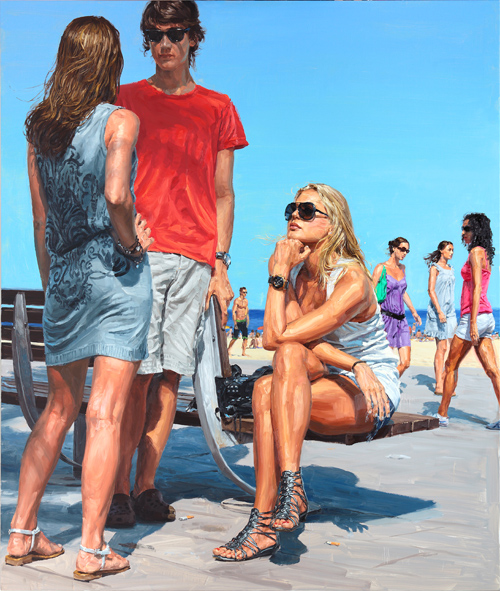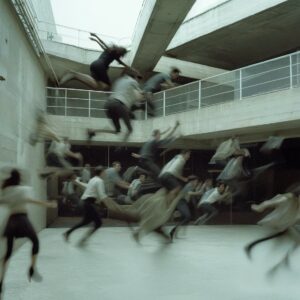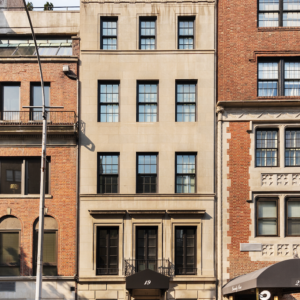
‘Youth has no age’ – Pablo Picasso.
Michele del Campo is, as his name suggests an Italian artist and is at
heart a very Mediterranean painter. We have here, beautiful young people, bathed in glorious sunlight, sitting against a backdrop of the sea or in urban settings that resonate with local favour rather than with inner city degradation. But as we examine some of the conceits behind the work we discover there is an inherent complexity in these seemingly innocent set ups.
After spending some time with him in the company of his work, I began
to understand more about his practice and the ideas behind his painting.
The first thing that struck me above anything else was this sense of
underlying drama in the constructs of his scenes. This effect I found
out was a very deliberate on his part and in fact there is throughout his
work constant intention and well thought out process. These figures
are frozen in a theatrical tableau, whereby composition is everything.
Indeed, Michele clearly enjoys playing with construction and in earlier
work we see cropped figures, torsos captured in a cinematic viewpoint.
When heads are left off and the picture plane cut through bodies we are reminded of the ballerinas by Degas, where some of the action takes place off stage.
It is this shifting perspective that interests the artist, making for more suggestive scenes, when direct expressions or limbs are excluded it is left to the viewer fill in the gaps. The source material is critical here as the subjects must be as alluring as the artistic arrangement.
Michele will go out with his sketchpad and camera and get attractive,
young people to pose in a setting of his choice. Back in the studio, he
will select the right combination of figures to build up the mise-en-scene.
One figure may reappear in certain paintings, or a figure taken isolation
may suddenly form part of a group. It is not just the figures themselves
that are re-arranged to suit the overall effect, but expressions and gazes are altered in order to obtain the desired narrative or suggestion.
It is this unspoken story that makes the work so intriguing, inviting us
the viewer to ask questions. Who are these people? What are their backgrounds and more importantly what is their relationship to each
other?
Hence the title of this show, ‘Close Strangers’, what interests Michele is
the group dynamic and how that even amongst friends, there is a sense
of personal isolation. This becomes even more apparent when the central figure is a beautiful girl, the object of desire. She is aware of her power and the sexual frisson that surrounds her. Michele will portray her as somewhat aloof and self-absorbed, often looking out into the middle distance.
If we take for instance the large diptych, ‘The Fair Girl’, the group is focussed around the Venus-like beauty in the middle and whilst the
alpha male tries to make a physical possession of her, she remains
detached. The same can said for the girl leaning against the scooter
in ‘The Proposal’, we can only guess at what the guy has offered her and his expectant smile speaks volumes, but again her gaze is not directed towards him, rather looks out halfway to the viewer as if to say, ‘can you do better?’ The girls here exhibit a certain amount of ennui; they have an expression of someone who has heard it all before and hence are beautifully bored. In ‘The Other Girl’, the seated blonde girl is feigning interest in the conversation, is the brunette with her back to us some kind of threat? Once again Michele consciously creates ambiguity, leaving the viewer free to interpret meaning and to guess at intention. There is though one consistent quality to these paintings is the fact that all the subjects are so young and attractive.
When pressed on his subject matter, Michele is quite open about
his obsession with youth and beauty. For him, like other artists the
representation of the idealised female is a means of release. This is a
cathartic process whereby lust and longing is expelled through artistic
creation. This male gaze can be found in Gauguin’s Tahitian dusky
beauties or through fashion photographer’s lens.
Michele is clearly concerned with aesthetics, but there is a dichotomy
at play here. The nubile girls and young men who populate his painting
are often set against a grittier environment. There is an effective visual
contrast, between the beauty of the figures and their urban background.
In terms of technique, Michele works wet on wet, with broad and confident brushstrokes. This is free and loose painting, not photo-realism.
The large scale of some of the work also relates to Michele’s dramatic
concerns. He wants to create a sense of intimacy of impact, by allowing the viewer to fully enter the scene portrayed. The colour palette is rich and saturated, lending the sun soaked scenes vibrancy through hue and tone.
Michele del Campo’s ability as a painter is beyond question and by careful orchestration of composition he is able to give each constructed
scene a powerful yet subtle narrative. We have implied interaction
through suggestion, with the main protagonist often being remote and
even coolly removed from the others.
‘Close Strangers’, hints at personal intimacy yet alludes to the essential
separateness we all exude. Michele is clearly a thoughtful and considered artist. The emotional impact of these paintings derives from the powerful combination of the interplay between tight social groups coupled with a
careful configuration. This is all heightened by the application of fresh
vivid colour in a dazzling sunlight. Here the youthful and the beautiful
are captured in an idealised manner, in a moment in time, were thoughts and desires stand still. They will be forever young.
Ben Austin – April 2010



